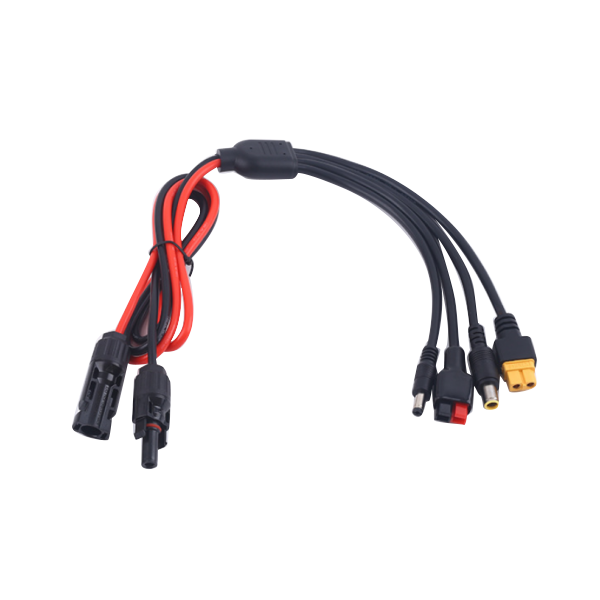Key Components of a Photovoltaic Wire Harness
2024-06-05
A photovoltaic (PV) wire harness is an assembly of electrical wires, connectors, and other components designed to interconnect various parts of a photovoltaic solar power system. These harnesses are essential for ensuring the efficient and reliable transmission of electrical power generated by solar panels to inverters, battery storage systems, and ultimately to the electrical grid or end-user applications.
Key Components of a Photovoltaic Wire Harness
1. Wires/Cables:
- PV Wires: Typically single-conductor, insulated wires rated for outdoor use, resistant to UV radiation, and capable of withstanding high temperatures.
- Multi-Conductor Cables: Used to bundle several wires together, reducing the complexity and improving the organization of the wiring system.
2. Connectors:
- MC4 Connectors: Commonly used in PV systems for their ease of installation and reliable performance in outdoor conditions.
- Quick Connect/Disconnect Systems: Facilitate easy and safe connections and disconnections during installation and maintenance.
3. Fuse and Protection Devices:
- Inline Fuses: Protect the wiring and components from overcurrent conditions.
- Surge Protection Devices: Safeguard the system against voltage spikes caused by lightning or other sources.
4. Junction Boxes:
- Combiner Boxes: Aggregate multiple strings of solar panels into a single output, simplifying connections to the inverter.
- Connection Boxes: Provide a secure location for making electrical connections, often including protective elements like fuses and breakers.
5. Cable Management:
- Conduits: Protect and organize the wires, preventing damage and reducing the risk of electrical faults.
- Cable Ties and Clamps: Secure the wiring to structures, ensuring it remains in place and organized.
6. Labeling and Identification:
- Markers and Tags: Clearly identify different wires and components, aiding in troubleshooting and maintenance.
Advantages of Using a Photovoltaic Wire Harness
1. Simplified Installation:
- Pre-Assembled: Harnesses are often pre-assembled and tested, reducing installation time and labor costs.
- Plug-and-Play: Standardized connectors and organized wiring make the installation process straightforward.
2. Enhanced Reliability:
- Quality Control: Pre-manufactured harnesses undergo rigorous testing, ensuring high-quality connections and reducing the risk of faults.
- Durability: Components are designed to withstand harsh environmental conditions, including UV exposure, temperature variations, and moisture.
3. Safety:
- Protection Devices: Integrated fuses and surge protectors enhance the safety of the system by preventing electrical faults.
- Organized Wiring: Reduces the risk of short circuits and electrical fires.
4. Maintenance and Troubleshooting:
- Clear Identification: Labeled wires and standardized connectors make it easier to identify and fix issues.
- Modular Design: Allows for easy replacement of faulty components without extensive rework.
Applications of Photovoltaic Wire Harnesses
1. Residential Solar Power Systems:
- Rooftop Installations: Connecting solar panels to inverters and battery storage systems in residential settings.
- Ground-Mounted Systems: Used in larger residential installations with ground-mounted solar arrays.
2. Commercial and Industrial Solar Power Systems:
- Large-Scale Installations: Interconnecting vast arrays of solar panels in commercial buildings, factories, and warehouses.
- Solar Farms: Essential in utility-scale solar farms for connecting and managing extensive solar panel arrays.
3. Off-Grid Solar Power Systems:
- Remote Locations: Providing power in remote areas without access to the electrical grid, such as rural communities, remote facilities, and temporary installations.
- Portable Solar Systems: Used in mobile applications like RVs, boats, and remote monitoring stations.
Maintenance Considerations
1. Regular Inspections:
- Visual Checks: Periodically inspect for signs of wear, damage, or corrosion on wires and connectors.
- Connection Tightness: Ensure that all connections remain tight and secure to prevent electrical faults.
2. Cleaning:
- Component Cleaning: Keep connectors and junction boxes clean and free from debris to maintain optimal performance.
- Panel Cleaning: Regularly clean solar panels to ensure maximum efficiency, as dirt and dust can impede performance.
3. Monitoring and Testing:
- Performance Monitoring: Use monitoring systems to track the performance of the solar power system and detect any issues early.
- Electrical Testing: Periodically test the electrical connections and protection devices to ensure they are functioning correctly.
4. Environmental Protection:
- UV Protection: Ensure that all exposed wires and components are UV resistant to prevent degradation.
- Weatherproofing: Protect components from moisture and extreme weather conditions to prevent corrosion and other damage.
Common Challenges and Solutions
1. Connector Failures:
- High-Quality Connectors: Use reliable connectors like MC4 to ensure robust connections.
- Regular Inspections: Periodically check connectors for signs of wear or damage.
2. Cable Damage:
- Protection: Use conduits and proper cable management to protect wires from physical damage.
- Environmental Considerations: Ensure cables are rated for the specific environmental conditions they will face.
3. Overcurrent Protection:
- Fuses and Breakers: Ensure the system includes appropriate fuses and circuit breakers to prevent damage from overcurrent situations.
- Regular Testing: Test protection devices periodically to confirm they are functioning correctly.
By understanding the components, advantages, applications, and maintenance considerations of photovoltaic wire harnesses, you can ensure the reliable and efficient operation of solar power systems across various settings.



